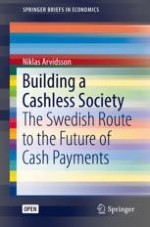Open Access 2019 | Open Access | Book

Building a Cashless Society
The Swedish Route to the Future of Cash Payments
Author: Assoc. Prof. Niklas Arvidsson
Publisher: Springer International Publishing
Book Series : SpringerBriefs in Economics
Open Access 2019 | Open Access | Book

Author: Assoc. Prof. Niklas Arvidsson
Publisher: Springer International Publishing
Book Series : SpringerBriefs in Economics
This open access book tells the story of how Sweden is becoming a virtually cashless society. Its goal is to improve readers’ understanding of what is driving this transition, and of the factors that are fostering and hampering it. In doing so, the book covers the role of central banks, political factors, needs for innovation, and the stakeholders involved in developing a cashless ecosystem. Adopting a historical standpoint, and drawing on a unique dataset, it presents an academic perspective on Sweden’s leading role in this global trend.
The global interest in the future of cash payments makes the Swedish case particularly interesting. As a country that is close to becoming a cashless economy, it offers a role model for many other countries to learn from - whether they want to stimulate or reduce the use of cash. This highly topical book will be of interest to politicians, researchers, businesses, financial service providers and payment service providers, as well as fintech start-ups, regulators and other authorities.